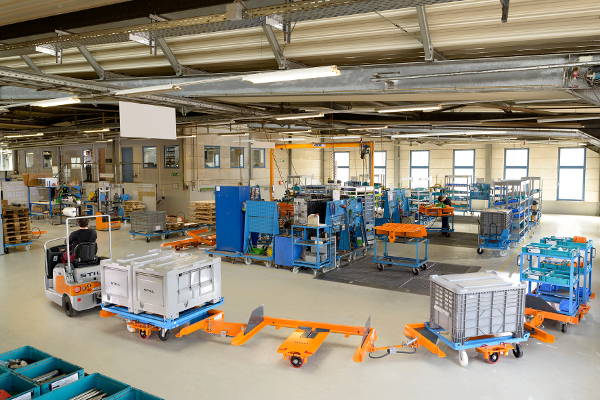STILL to showcase its LiftRunner tugger train system at CeMAT 2016

A STILL LiftRunner tugger train system consists of a towing truck and a flexible combination of various tugger train elements such as LiftRunner E-frames.
Photo by STILL GmbH
STILL will showcase itself under the motto “Simply Smart” at CeMAT 2016, the world’s leading intralogistics trade fair taking place in Hanover, Germany, from 31 May to 3 June. The Hamburg intralogistics specialist will show innovations in the areas of forklift truck, warehousing and materials flow technology in Pavilion 35 on the outdoor area. The LiftRunner tugger train system, which proves STILL’s competence in the Lean Logistics area, will be one of the highlights of the trade fair. As well as various towing trucks and types of frames and trolleys, STILL will show an automated system for loading and unloading trolleys. This saves the operator at the loading point the annoying need to climb on and off the truck.
In 2015, by acquiring LR Intralogistik GmbH, a specialist for forklift-free intralogistics material transport using tugger train elements, STILL strengthened its know-how in process-oriented material flow concepts, including automated solutions. One of the outcomes is the LiftRunner tugger train system, which can be optimally customised to specific operational situations and focuses on process reliability, cost efficiency, safety and ergonomics.
Two STILL tugger train systems that have been in use since April 2016 in the newly opened Pals (Production and Logistics Systems) technology centre at the Landshut University of Applied Sciences in Dingolfing have already shown that this is not just an empty promise. The Centre is built like a fully-functioning medium-sized company, and deals with the latest knowledge about intelligent flows of goods and lean management for production operations. It is designed to act as an interface between theory and practice, and to provide an opportunity for research and the exchange of experience. STILL’s LiftRunner tugger trains have proved here that they can be adapted in an optimum way to individual operational framework conditions, with continuous uninterrupted production from incoming materials to outgoing goods.
A STILL LiftRunner tugger train system consists of a towing truck (e.g. a tractor in the CX-T, LTX or R 07 model series) and a flexible combination of various tugger train elements such as train-mounted trailers to accommodate trolleys, the so-called LiftRunner B-, E- and C-frames, and trolleys loaded with all kinds of load carriers or products. The trolleys are pushed into the STILL LiftRunner frames and secured. Depending on the coupling direction, they can be loaded from the right or left (E- and C-frames), or from both sides (B-frames), so there is no need to change the coupling of the frames. When the driver enters the towing truck, the trolleys are automatically raised. This not only protects the rollers but also reduces driving noise. The required lifting energy is provided pneumatically, hydraulically or electrically via the towing truck and also autonomously via the frame. There is no need for the operator to exert any physical force. The frames lower automatically when the operator leaves the towing truck, and the trolleys can be removed without any risk to his back. The trolleys are fitted with polyamide rollers to minimise rolling resistance, so heavy loads can be moved more easily.
With a wide range of trolleys and STILL LiftRunner frames, tugger trains can be assembled in a needs-based, time- and space-saving way to supply parts to a number of decentrally organised fabrication points in a single tour on the so-called milk-run principle, i.e. materials in a variety of load carriers are conveyed to the assembly points just-in-time, and finished components are carried away. The factory operator not only saves expensive logistics space, but can also reduce stock levels and energy consumption, as well as decreasing the risk of accidents through a smaller volume of traffic.
For more information, please visit http://www.still.de.
News Categories
- » NEWS HOME
- » Automation & Robotics
- » Industry 4.0
- » Material Handling
- » Sensors
- » Quality & Testing
- » Machine Vision
- » Laser & Optics
- » Metalworking
- » Motion Control & Drives
- » Hydraulics & Pneumatics
- » Process Industry
- » Renewable Energy
- » Agriculture
- » Home & Office Furniture
- » Environmental Tech



